Japan: A Short Cultural History
Select Format
Select Condition 
Book Overview
Japan: A Short Cultural History was first published in 1931 by the Cresset Press in London and D. Appleton in New York. Writing in the Journal of American Oriental Society in 1959, Edwin O. Reischauer, Harvard professor and leading scholar in Japanese history and culture (and future United States Ambassador to Japan) said this of George Sansom's comprehensive account of Japanese history: "When Sir George Sansom's Japan:...
Format:Paperback
Language:English
ISBN:0804709548
ISBN13:9780804709545
Release Date:June 1931
Publisher:Stanford University Press
Length:564 Pages
Weight:1.45 lbs.
Dimensions:1.6" x 5.4" x 8.5"
Customer Reviews
3 ratings
Sir George Sansom (1883-1965) Revisited
Published by Thriftbooks.com User , 19 years ago
It would probably not be much of a stretch to claim that as late as the decade following the end of the Pacific War in 1945, the popular take in the States on things Japanese, even among the more knowledgeable, was shaped largely by three classics: Sir George Sansom's Japan: A Short Cultural History (1931) and Ruth Benedict's The Chrysanthemum and the Sword (1946) against the background strains of Puccini's Madama Butterfly (1904). All three have had their critics and all three have survived comfortably into the 21st century. But the Cultural History is not just curious relic. It often describes, in clear and straightforward terms, items of cultural behavior which contemporary scholars are often tempted to dispute contentiously, present in technical jargon, or ignore completely. Take, for example, this introduction to the crucial distinction in Shinto between "ritual purity" and "moral guilt": . . . . . . . . The outstanding feature of Shinto observances is the attention paid to ritual purity. Things which are offensive to the gods were called by the early Japanese TSUMI, a word which is now rendered by dictionaries as "guilt" or "sin." Avoidance of these things was called IMI, a word meaning taboo. The Imibe, as we have seen, were a class of professional "abstainers," whose duty it was to keep free from pollution so that they might approach the gods without offence. Chief among the offences to be avoided was uncleanness. It might arise in many ways, none of which in other religions would be moral guilt. . . (p. 32ff.) Those with a bigger appetite for historical detail might consider starting, or continuing, with Sansom's later 3-volume narrative history: A History of Japan to 1334 (1958), A History of Japan 1334-1615 (1961), and A History of Japan 1615-1867 (1963). Sansom's stated reason for not continuing his history beyond 1867 is that he had lived too close to events of the Meiji Restoration (1868) for him to develop a perspective that only distance could supply. For readers interested in later events, The Making of Modern Japan (2000; 2002), by Marius B. Jansen, another outstanding scholar of Japanese history, would be a good choice. Since this history begins at 1600, there are overlapping accounts of the Edo period, but from two quite different perspectives.
With some skimming, a very good introduction.
Published by Thriftbooks.com User , 21 years ago
While interested in culture, I have come to realize I am not very interested in cultural history. For one thing, it is difficult to convey a history of art or architecture or literature to a reader unless the reader is already conversant with historical examples of all of these. It is also true, for me at least, that a discussion of religious and philosophical ideas from a modern perspective, with reference to historical changes, is more enlightening than an attempt at a chronological history. On the other hand, cultural histories, such as Sansom's can provide political histories of just the right amount of detail, and this book does; and Sansom is generally able to convey the flavor of a Japanese cultural epoch. The book lacks a proper emphasis on economic and technical history. Possibly, this is due to gaps in the historical record, at least at the time this book was written (1931), since Sansom does pay attention to economics in the late stages of this book. The book does successfully stress morality and character. A Short Cultural History ends just before the Restoration in mid-19th century. The book's style is pleasantly informal, more in the style of an essayist than an academic. And despite the reservations I have expressed, I found that with a certain amount of skimming, it provides a very good introduction, one that encourages more reading. I give it 5 stars because of the challenge of writing a book such as this.
A great reference tool on Japan
Published by Thriftbooks.com User , 22 years ago
I purchased this book at great cost but it has been worthwhile. It provides a concise overview of Japanese culture. It is the only book I have found to be so informative without the "fluff" of other books. I don't know about this one but the one I purchased is of fantastic high quality paper that makes such a small book rather heavy. A great book for anybodies reference library.






